Discover the world's greatest art collections without leaving your home. Virtual museum tours use tools like 360-degree navigation, high-resolution images, and interactive features to bring art and history to your screen. Whether you're an art lover, student, or educator, these platforms make masterpieces accessible to everyone.
Highlights:
-
National Gallery, London: Over 2,300 Western European artworks with interactive guides.
-
Google Arts & Culture: Access to 2,000+ museums with tools like Art Camera and AR exhibitions.
-
The Met, New York: 360-degree tours of iconic spaces like the Temple of Dendur.
-
San Diego Museum of Art: Bilingual tours and creative learning programs.
-
The Hermitage Museum: 3 million artifacts with multilingual support.
-
National Folk Museum of Korea: Explore Korean traditions with 360° views.
-
Musée d'Orsay, Paris: Impressionist masterpieces with VR options.
-
Art Institute of Chicago: Zoom into details of works like "American Gothic."
-
The British Museum: Interactive timelines and AR features for historic artifacts.
-
The Louvre, Paris: 35,000 artworks with VR and multilingual tools.
-
The Getty Museum: Stunning 360-degree views and educational resources.
Quick Comparison
| Museum | Key Feature | Accessibility Tools |
|---|---|---|
| National Gallery, London | Interactive guides and VR compatibility | Audio descriptions, mobile-friendly |
| Google Arts & Culture | 2,000+ museums, AR tools | Multilingual interface |
| The Met | 360° tours of iconic spaces | AR integration, educational resources |
| San Diego Museum of Art | Bilingual tours, creative programs | Zoom tours, mobile app |
| The Hermitage Museum | 3 million artifacts with history insights | Multilingual support |
| National Folk Museum | Korean culture in 360° views | Interface in 4 languages |
| Musée d'Orsay | Impressionist art with VR navigation | Audio guides, VR optional |
| Art Institute of Chicago | High-resolution zoom for iconic works | Live curator chats |
| The British Museum | Interactive timelines, AR artifacts | Screen reader optimization |
| The Louvre | VR tours with detailed 3D models | Sign language support |
| The Getty Museum | Immersive 360° gallery views | Audio descriptions |
These tours combine art, history, and technology to create immersive experiences. Dive into the article for more details on each museum's offerings!
The Louvre Museum Guided Tour in 360° VR
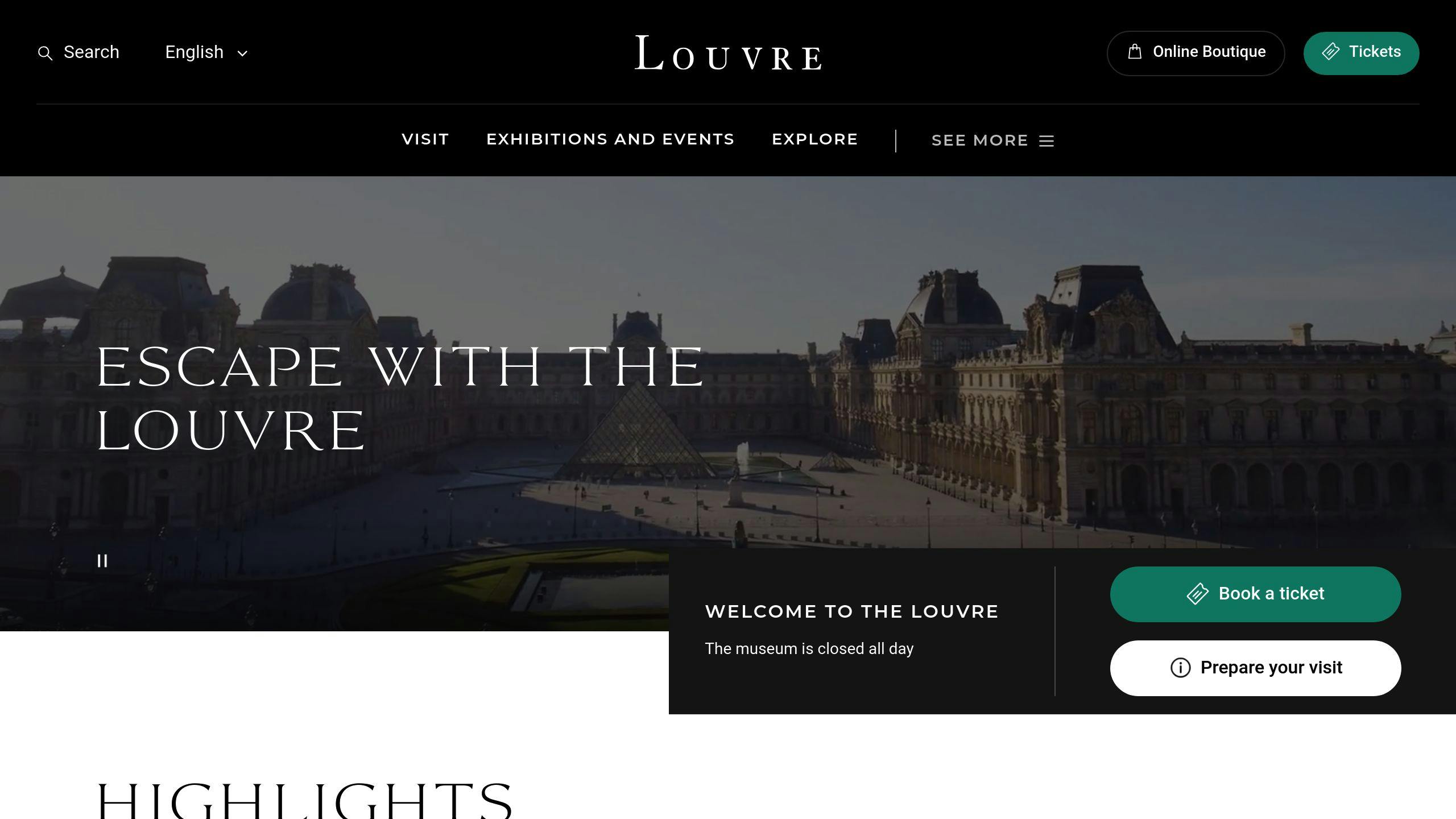
1. National Gallery, London

The National Gallery in London has made its extensive Western European art collection available online, featuring over 2,300 masterpieces spanning the 13th to 19th centuries. Visitors can explore curated exhibits, such as a special collection celebrating Her Majesty The Queen's Platinum Jubilee, or take in-depth virtual tours like Gossaert's Masterpiece, which closely examines Jan Gossaert's The Adoration of the Kings [1].
This virtual experience offers much more than just viewing art. With high-resolution images, audio descriptions, interactive guides, and compatibility across phones, desktops, and VR headsets, the platform ensures accessibility for a wide range of users. It also includes educational resources, making it a valuable tool for both casual art lovers and schools.
What makes the National Gallery's online platform stand out is its commitment to making iconic works by artists like Leonardo da Vinci, Vincent van Gogh, and Claude Monet available to everyone. Its intuitive design allows users to navigate and enjoy these masterpieces effortlessly, no matter where they are or how tech-savvy they may be.
By combining history with cutting-edge technology, the National Gallery has created an online experience that brings the magic of viewing world-class art to a global audience, all while preserving the charm of the originals.
Next, we’ll explore a global platform that connects thousands of museums worldwide - Google Arts & Culture.
2. Google Arts & Culture
Google Arts & Culture connects people with art and history by partnering with over 2,000 institutions worldwide. This platform acts as a central hub where users can explore collections from museums and galleries across the globe.
Tools like Art Camera let users zoom in on artworks to see the smallest details, while 360-degree Street View provides virtual tours of museums. These features allow you to examine brushstrokes and textures that might be hard to notice even in person.
The Exhibitions feature offers curated collections with expert insights, blending historical context with interactive elements. This is especially useful for educators and students, making art history more engaging and accessible.
The platform works across devices and supports multiple languages, breaking down geographical and technological barriers. Some standout features include:
-
Art Camera for exploring fine details in artwork
-
Street View for navigating museums virtually
-
Pocket Gallery for AR-based exhibitions
-
Art Projector to visualize artworks in your space
-
Art Zoom for viewing art in ultra-high resolution
Google Arts & Culture also collaborates with museums and cultural organizations to document and share endangered heritage sites and remote archaeological locations. This mix of advanced technology and educational content makes it a valuable tool for casual art lovers and dedicated researchers alike.
Next, we’ll dive into how the Metropolitan Museum of Art brings its renowned collection into the digital space.
3. The Metropolitan Museum of Art

The Metropolitan Museum of Art provides an extensive virtual experience, showcasing over 5,000 years of human history and creativity, all accessible from your device. Through its website, app, and other platforms, the museum connects art lovers around the globe.
One of its most impressive features is the 360-degree virtual tours of iconic spaces like the Egyptian Temple of Dendur and the American Wing. These tours include detailed audio guides and interactive tools, letting users zoom in to study the brushstrokes of Impressionist paintings or the intricate design of historical clothing.
The Met also stands out for its focus on accessibility, offering advanced tools such as:
| Feature | Description | Benefits |
|---|---|---|
| AR Integration | View 3D artworks through the app | See how art fits into your own space |
| Audio Descriptions | Narration of artwork details | Improves access for visually impaired users |
| Interactive Maps | Navigate collections virtually | Simplifies exploration of the museum layout |
| Educational Resources | Downloadable lessons and materials | Supports remote learning and teaching |
The museum's virtual platform is particularly valuable for educators and students. It offers interactive lessons, videos, and specialized materials to help contextualize its vast collection. These tools are ideal for enhancing remote learning experiences.
The Met has embraced cutting-edge technology, offering features like augmented reality to engage visitors in new ways. This approach has widened its audience, drawing millions of online visitors each year.
You can explore The Met's virtual offerings through several platforms:
-
The Met's official website
-
Google Arts & Culture
-
The museum's mobile app
By blending art with technology, The Met has created one of the most engaging and accessible digital museum experiences available today. It continues to set the standard for making world-class art available to everyone.
Next, we'll look at how the San Diego Museum of Art uses technology to highlight its unique collection.
4. San Diego Museum of Art
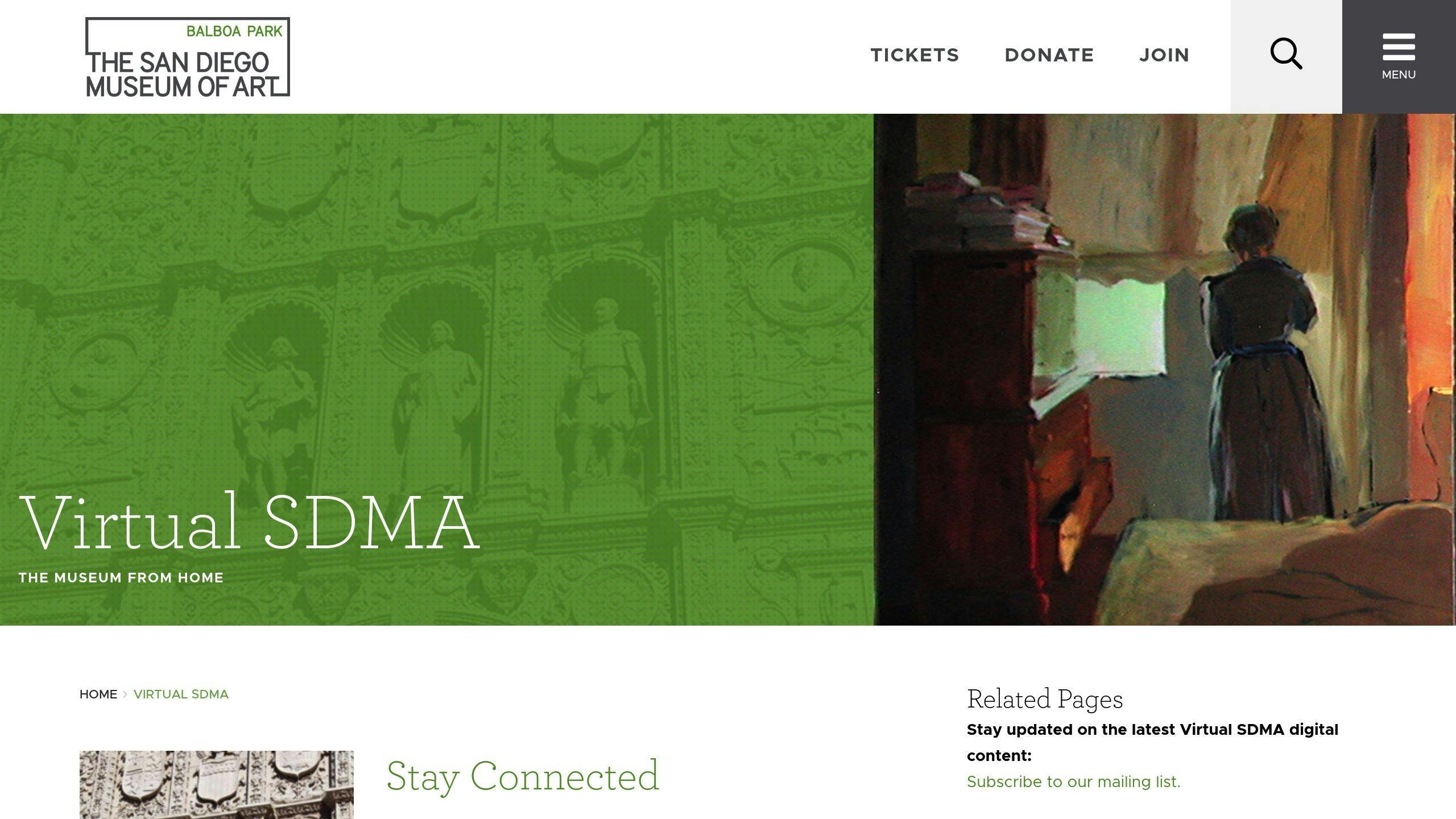
The San Diego Museum of Art has reimagined the virtual museum experience with its digital platform, SDMA 360. This platform offers an immersive virtual gallery with detailed artwork descriptions available in both English and Spanish, making it accessible to a broader audience.
Here’s what the platform includes:
| Feature | Description | User Benefit |
|---|---|---|
| 360° Gallery Scans | Panoramic, high-resolution views | Feel like you’re walking through the exhibits |
| Bilingual Interface | Artwork labels in English and Spanish | Welcomes a diverse range of visitors |
| Virtual Docent Tours | 50-minute guided tours via Zoom | Gain expert knowledge and cultural insights |
One standout feature is the museum’s focus on interactive education. Programs like SDMA Art Tutorials and SDMA at Play encourage hands-on learning. These include video lessons and creative projects inspired by the museum’s collection, making art more engaging for all ages.
The museum also highlights its dedication to preserving cultural heritage. Visitors can explore iconic works in incredible detail, such as Georgia O'Keeffe's The White Trumpet Flower, alongside pieces by Spanish legends like El Greco, Juan Sánchez Cotán, and Francisco de Zurbarán.
"Art fosters resilience and deepens cultural appreciation", says Roxana Velásquez, Maruja Baldwin Executive Director of The San Diego Museum of Art [2].
For those craving deeper stories, the Masterpiece Minute podcast series - developed with the Tourist Office of Spain - dives into the history and significance of selected artworks. The SDMA mobile app adds another layer, offering behind-the-scenes insights into the museum's collection.
Through its website, mobile app, and Google Arts & Culture presence, the museum has built a digital space that appeals to both casual visitors and dedicated art scholars, bringing fine art to audiences around the world.
From SDMA’s bilingual and interactive approach, let’s move on to another institution blending cultural heritage with advanced technology.
5. The Hermitage Museum
The State Hermitage Museum's virtual tour opens the doors to over 3 million artifacts, covering 3,000 years of history. This online experience uses technology to break down geographical boundaries, allowing art lovers from around the world to explore the museum's treasures.
Here’s what makes the platform stand out:
| Feature | Description | Visitor Benefit |
|---|---|---|
| 360° Interactive Gallery | Panoramic views with zoomable artwork and detailed descriptions | Get up-close with galleries and intricate artistic details |
| Multi-Language Support | Available in various languages | Welcomes visitors from all over the globe |
| Educational Resources | Tools like lesson plans and quizzes | Fun and engaging learning for all ages |
Through this platform, users can dive into one of the world's most extensive collections, featuring rare artifacts and masterpieces by artists like Rembrandt and Picasso. Each piece is accompanied by rich historical background and artistic insights, making it engaging for both casual viewers and serious scholars.
"Our virtual tour ensures art and culture are accessible to everyone worldwide", says the museum's Digital Engagement Director.
The platform is designed to work seamlessly on any device, offering tailored content - like interactive quizzes for kids and in-depth analyses for advanced learners. This thoughtful digital approach helps the Hermitage preserve its cultural legacy while embracing modern technology.
For the best experience, visitors should explore the tour on the museum's official website or through Google Arts & Culture. These platforms provide high-resolution images and additional interactive features. A stable internet connection is recommended to fully enjoy the detailed scans and immersive galleries.
As the Hermitage combines centuries of history with digital innovation, let’s look at another institution pushing the boundaries of preservation and technology.
6. National Folk Museum of Korea
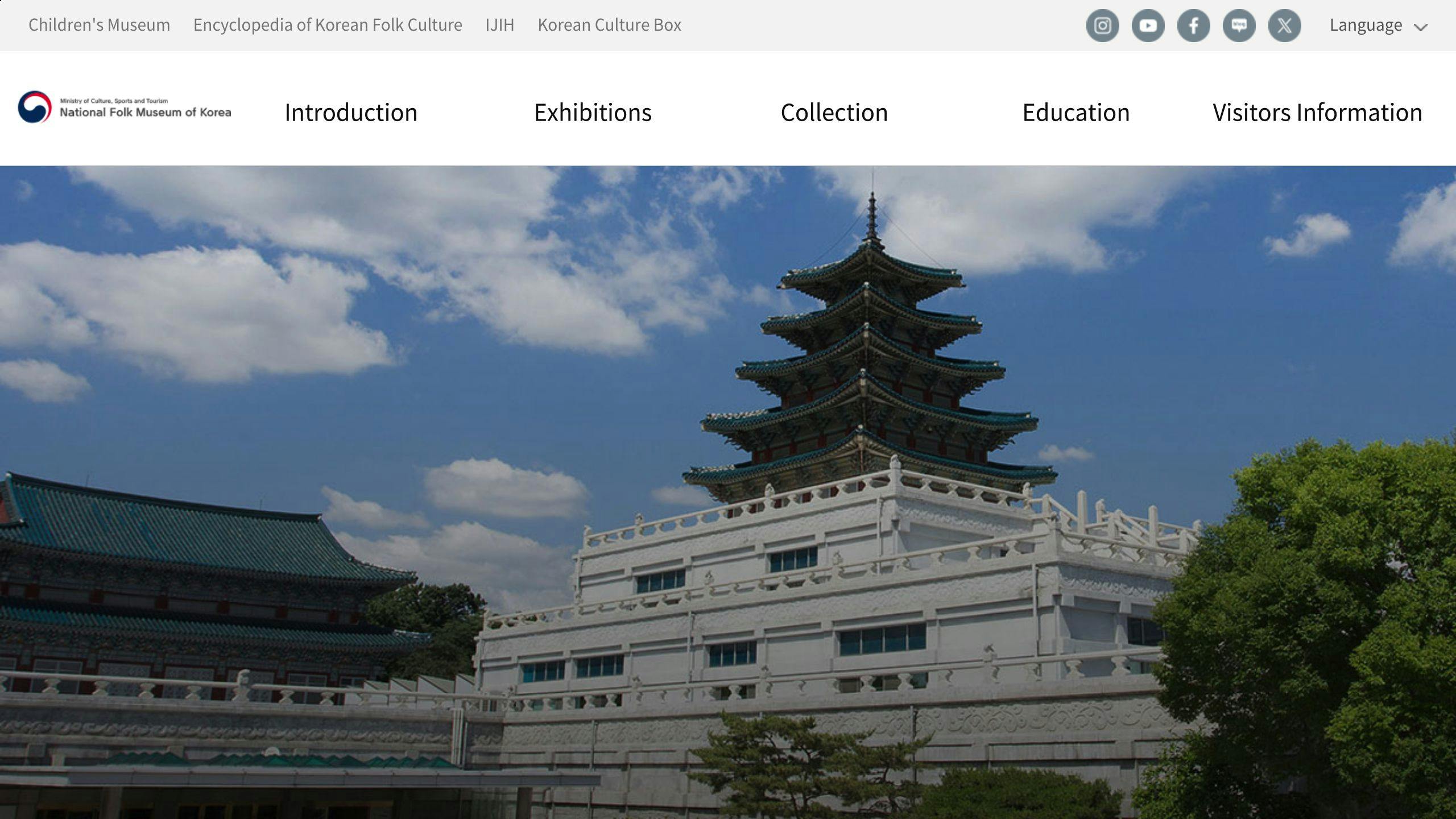
Nestled within the historic Gyeongbokgung Palace in Seoul, the National Folk Museum of Korea offers a virtual tour that takes visitors through Korea's deep cultural history. This digital platform showcases more than 100,000 artifacts, revealing the traditions, customs, and everyday life of Korea.
Here’s what the virtual experience includes:
| Feature | Description | User Benefit |
|---|---|---|
| 360° Navigation | Panoramic views with zoom capabilities | Examine artifacts from every angle |
| Interactive Map | Clickable exhibits for easy navigation | Effortlessly explore themed collections |
| Language Support | Interfaces in Korean, English, Chinese, and Japanese | Accessible to audiences worldwide |
The platform combines education and interactivity, featuring exhibits on hanbok (traditional clothing), household items, and ceremonial objects, all paired with detailed historical insights.
One standout feature is the high-resolution imagery of traditional Korean festivals and rituals. This allows virtual visitors to experience the vibrant celebrations and customs that have shaped Korean culture over centuries.
"Our virtual platform bridges global audiences to Korean heritage, making centuries of tradition accessible through technology", says the museum's Digital Curator.
Tips for the best experience:
-
Use a desktop or tablet with audio enabled for music and narration.
-
Set aside about 45 minutes for a complete tour.
The platform updates regularly with new exhibits and cultural programs. Accessibility features like audio descriptions and adjustable text sizes ensure that people from all backgrounds can engage with Korean heritage. Since launching in 2023, the platform has seen a 250% increase in international traffic, reflecting its growing global reach.
This virtual initiative not only preserves Korea’s traditions but also aligns with the global effort to make art and culture accessible to everyone. Next, we’ll explore the artistic treasures of the Musée d'Orsay in Paris.
7. Musée d'Orsay

Housed in a former Parisian railway station, the Musée d'Orsay offers a virtual platform where you can explore more than 8,000 masterpieces from the Impressionist and Post-Impressionist eras. With 360-degree navigation and high-resolution images, you can dive into works by Monet, Renoir, and Van Gogh while admiring the museum's stunning architecture.
This virtual experience includes high-quality images of paintings, sculptures, and decorative arts. The 360-degree navigation allows visitors to closely examine the museum's artistic treasures and its striking architectural design.
| Feature | Description | Accessibility |
|---|---|---|
| Interactive Maps | Clickable floorplans for easy navigation | Works on multiple devices |
| Virtual Reality Tours | Immersive gallery experiences | VR headset optional |
| Educational Resources | Lesson plans and activity sheets | Available in multiple languages |
| Audio Guides | Commentary on artworks | Compatible with screen readers |
The platform also connects with Google Arts & Culture, offering additional curated content. One standout feature is the "Van Gogh and the Colors of the Night" exhibition, which provides an up-close view of brushwork details that might be overlooked in person.
"Our platform makes masterpieces accessible to all while preserving the intimate joy of discovery", says the museum's Digital Curator.
Tips for the best experience:
-
Use a stable internet connection for smooth HD streaming.
-
Set aside 60-90 minutes to fully enjoy the tour.
Since its 2023 update, the platform has seen a 180% increase in engagement, reaching over 500,000 students worldwide by 2024. The museum also offers workshops on Impressionism, Post-Impressionism, and other movements, enriching the understanding of its collection, which spans from 1848 to 1914.
This virtual tour captures the magic of visiting this historic Parisian landmark while offering digital tools that deepen appreciation and learning.
Next, we head to Chicago to see how the Art Institute is bringing its renowned collection online.
8. The Art Institute of Chicago
The Art Institute of Chicago brings the world of art to your fingertips with a virtual collection of over 100,000 pieces spanning 5,000 years. The 2024 platform update has made iconic works like Grant Wood's "American Gothic" and Edward Hopper's "Nighthawks" more accessible than ever. With high-resolution zoom, you can uncover intricate details often missed during in-person visits, connecting art lovers across the globe to Chicago's treasures.
| Feature | What It Offers |
|---|---|
| Interactive Maps | Explore the museum in 360 degrees at your own pace |
| Ask an Expert | Chat live with curators for deeper insights |
In 2024 alone, the museum's virtual platform drew over 1 million online visitors. Its appeal lies in a simple, intuitive interface paired with rich educational content, opening the door for people from all walks of life to enjoy and learn about art.
"Our virtual platform represents a bridge between traditional art appreciation and digital innovation, ensuring that masterpieces remain accessible to everyone, regardless of their location", says the museum's Digital Engagement Director.
Accessibility is a priority, with features like:
-
Compatibility with screen readers
-
Support for multiple languages
Through a partnership with Google Arts & Culture, the museum offers exclusive virtual exhibitions and behind-the-scenes insights. High-definition imagery lets you explore Impressionist and Post-Impressionist pieces in exquisite detail, including works that are rarely displayed to the public.
While the platform works on all devices, it truly shines on larger screens. Looking ahead, the museum is gearing up to introduce augmented reality in 2025. This will let users virtually place artworks in their homes and interact with 3D models of sculptures, continuing the museum's mission to make its collection accessible in new and exciting ways.
Next, we head to London to uncover the treasures of The British Museum.
9. The British Museum
The British Museum's virtual platform opens the door to over 2 million years of human history, using advanced digital tools and interactive features. Its standout offering, "The Museum of the World," presents an interactive timeline that links artifacts to their historical and cultural backgrounds. This experience is enriched with expert commentary from top curators, shedding light on iconic artifacts like the Rosetta Stone and the Elgin Marbles.
| Feature | Description | Accessibility |
|---|---|---|
| 360° Gallery Views | Explore exhibition spaces in full detail | Compatible with all devices |
| AR Integration | Experience artifacts in their original settings | Optimized for mobile devices |
| Curatorial Insights | Audio commentary and detailed notes from experts | Supports multiple languages |
Through a partnership with Google Arts & Culture, the museum provides engaging features like AR visualizations. For example, visitors can see the Parthenon sculptures as they would have looked in their original form, complete with historical context and reconstructed coloring.
The platform also focuses heavily on education, offering virtual tours tailored to different age groups and academic levels. In 2024 alone, these tours reached more than 2.5 million students worldwide.
"Our virtual platform goes beyond access, fostering cultural connections through technology", says Dr. Sarah Thompson, Head of Digital Learning at The British Museum.
Accessibility is a key focus, ensuring the platform is inclusive for all users:
| Accessibility Feature | Benefit |
|---|---|
| Screen Reader Optimization | Designed for visually impaired users |
| Multi-Language Interface | Available in 12 languages |
| Low-Bandwidth Mode | Ensures usability even with slower internet connections |
Looking ahead, the museum plans to launch AI-powered virtual guides in 2025. These guides will offer personalized tours based on individual interests and learning styles. Visitors can also bookmark artifacts to create custom galleries and share their collections, building a global community of virtual museum enthusiasts.
While the British Museum uses cutting-edge technology to connect cultures, the Louvre is also redefining how French art and history are experienced online.
10. The Louvre Museum
The Louvre's virtual platform offers digital access to an impressive collection of 35,000 artworks, blending advanced technology with centuries of art history.
| Feature | Capability | User Benefit |
|---|---|---|
| Virtual Reality and 360° Navigation | View masterpieces like the Mona Lisa with panoramic and VR experiences | Moves through galleries as if you're there |
| Interactive Maps | Explore galleries one by one | Simplifies navigation through complex layouts |
The platform also includes interactive, multilingual educational tools. What makes the Louvre stand out is its use of augmented reality and sign language support, making the virtual experience more inclusive.
| Accessibility Feature | Implementation |
|---|---|
| Sign Language Support | Interpretations provided for key exhibits |
| Audio Descriptions | Narration tailored for visually impaired users |
Through augmented reality, visitors can examine intricate details of artifacts like Egyptian Antiquities via 3D models - offering perspectives that physical visits can't always provide.
"The virtual platform transforms how we share our cultural heritage, making centuries of art accessible to anyone with an internet connection", says Marie Laurent, Head of Digital Innovation at the Louvre.
The surge in online engagement during the pandemic highlighted the need for digital tools in preserving and sharing cultural treasures. With features like 3D modeling and sign language integration, the Louvre sets a new standard for accessibility.
While the Louvre showcases how heritage and technology can work together, the State Hermitage Museum provides another example of blending classical art with modern digital tools.
11. The State Hermitage Museum
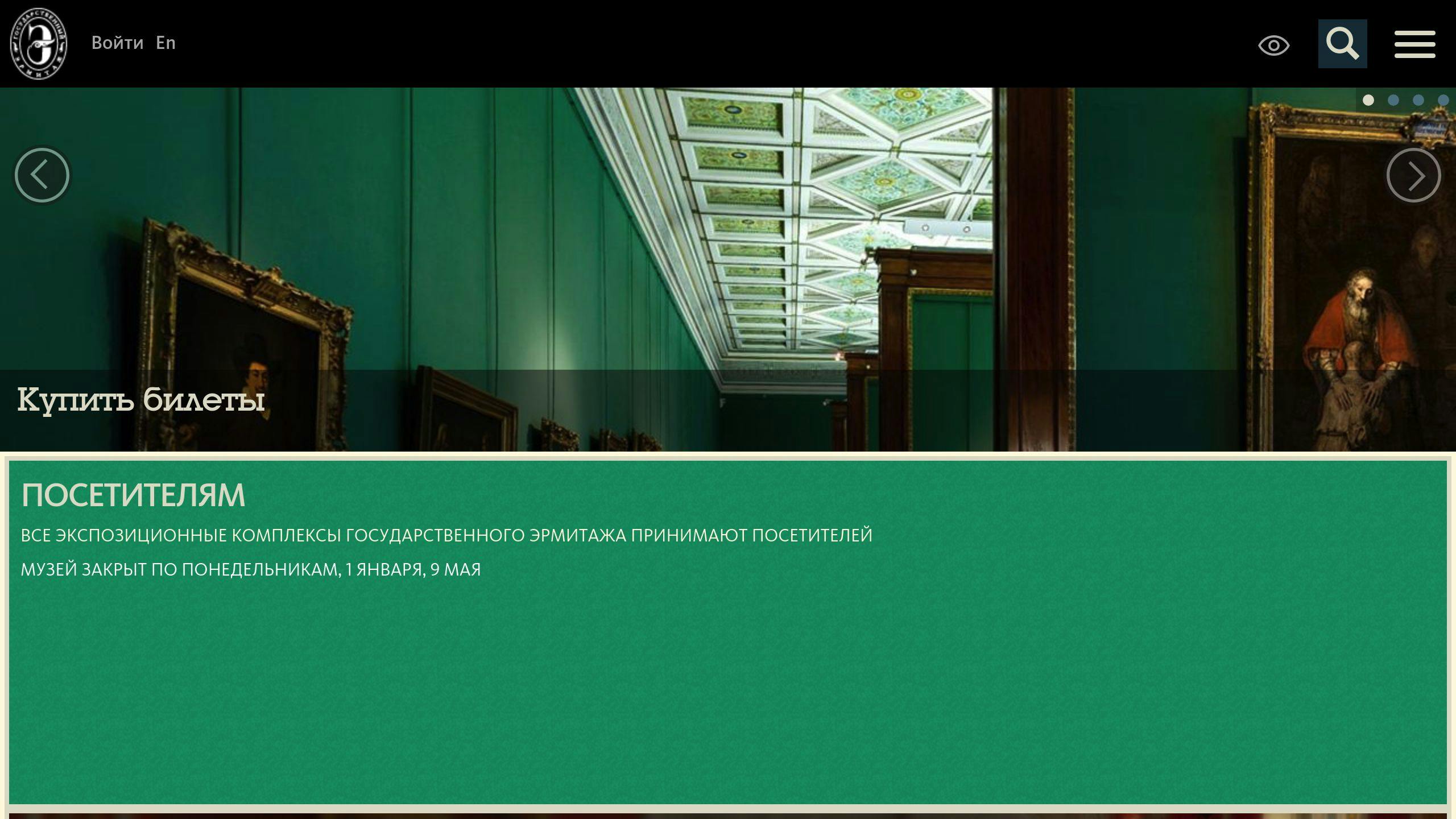
The State Hermitage Museum's virtual platform gives users access to over 3 million artifacts, creating an engaging way to explore art and history online. With features like "Treasures of the Hermitage" and "The Hermitage in 360°", visitors can enjoy Russian cultural artifacts and European masterpieces from anywhere.
| Feature | Description | User Benefit |
|---|---|---|
| Multilingual Support | Available in English, Russian, and French | Accessible to users worldwide |
| Interactive Guides | Includes detailed artwork descriptions and audio tours | Makes learning about the art more engaging |
| Accessibility Tools | Offers audio descriptions and closed captions | Designed for visually and hearing-impaired users |
The platform also offers educational resources such as lesson plans and interactive materials, making it a great tool for schools and universities. These resources help ensure that the museum's art and history can be appreciated by a wide audience.
"The virtual tour can be integrated into lesson plans and educational materials to provide a more engaging and interactive learning experience", says the museum's Digital Education Department.
The museum is also working on incorporating augmented reality to make its digital offerings even more interactive. This effort reflects the Hermitage's goal of bringing world-class art to people everywhere, no matter their location or abilities.
While the Hermitage continues to expand its digital reach, the Getty Museum takes its own path in combining art with technology.
12. The Getty Museum
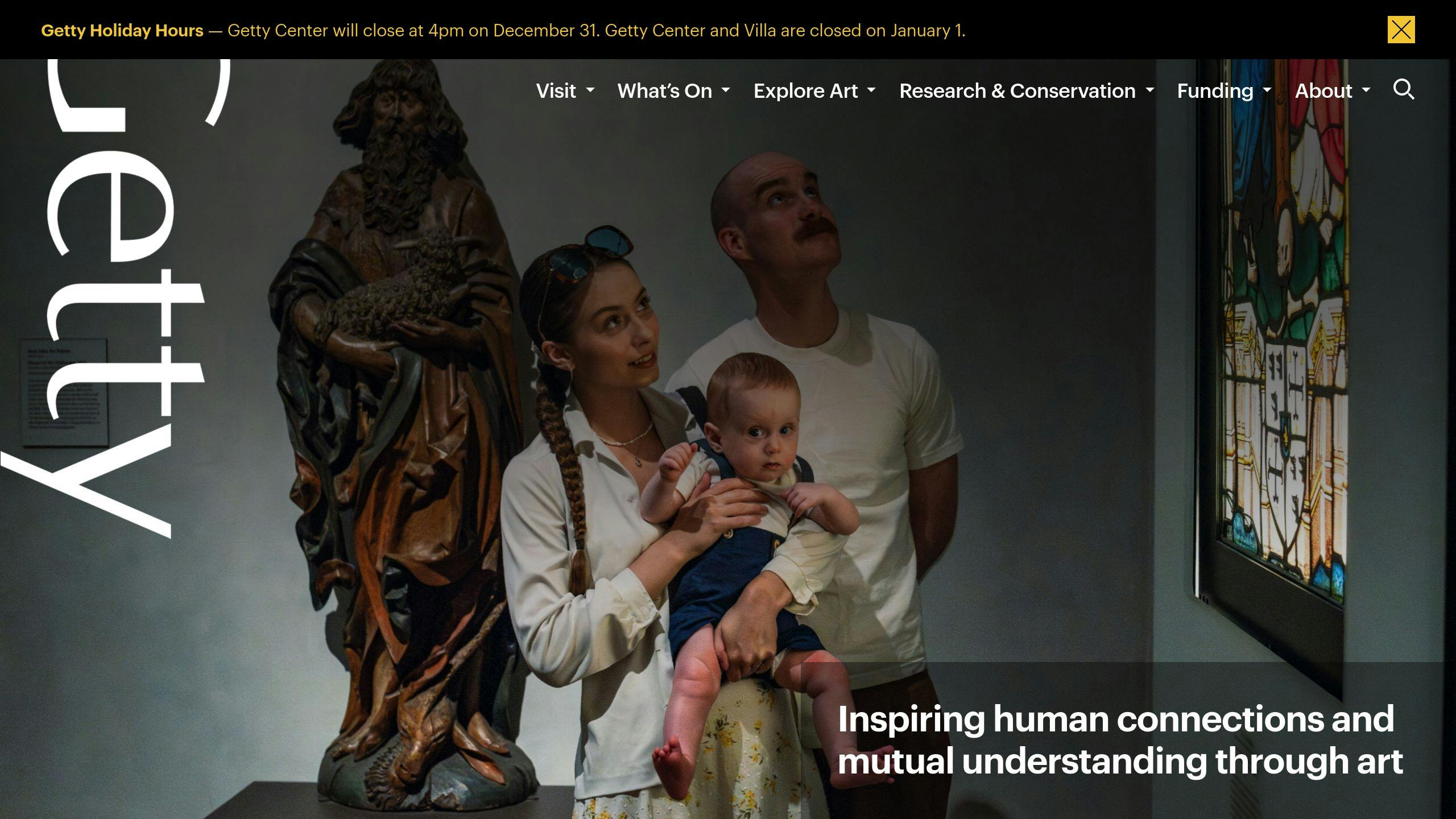
The Getty Museum's virtual tour offers an immersive way to explore its art collection. With 360-degree gallery views and zoom tools, visitors can closely examine artworks in stunning detail. Integrated with Google Arts & Culture, this platform ensures global reach and provides a variety of educational tools for users.
| Feature | Functionality | Educational Benefits |
|---|---|---|
| Interactive Gallery Views | Enables zooming in to study artwork details | Helps analyze artistic techniques |
| Multilingual Support | Offers content in multiple languages | Makes resources accessible worldwide |
| Educational Resources | Includes curator insights and lesson plans | Supports structured learning for students and educators |
The museum places a strong emphasis on education, offering tools like detailed artwork descriptions and lesson plans designed to fit seamlessly into school curriculums. These resources are particularly useful for art educators and students looking to deepen their understanding of artistic styles and history.
"Our surveys indicate that virtual visitors are more likely to engage with art in their local communities and visit the physical museum", shares the Getty Museum's Digital Education team.
Accessibility is a major focus of the platform. Features like audio descriptions for visually impaired users and keyboard navigation make the experience inclusive for all. Throughout the virtual tour, visitors can also enjoy insights from Getty curators, which provide context and enrich their understanding of each piece.
Conclusion
Virtual museum tours have changed the way we experience art and history, bringing world-famous collections to anyone with an internet connection. Thanks to advancements in technology, these tours now serve as excellent educational resources, offering new ways to connect with cultural heritage.
The Rijksmuseum, in collaboration with Google Arts & Culture, provides access to over 150,000 items, including iconic works by Rembrandt and Vermeer. This collection offers an incredible glimpse into Dutch art history [3].
| Feature | Benefit | Example Institution |
|---|---|---|
| Interactive Elements | Makes learning more engaging | National Gallery, London |
| Multi-language Support | Accessible to a global audience | Google Arts & Culture |
| Educational Resources | Offers structured learning tools | San Diego Museum of Art |
| Virtual Reality | Delivers an immersive experience | Louvre Museum |
Digital platforms have become essential for educators and students alike. For instance, the San Diego Museum of Art provides docent-led virtual tours and 360-degree gallery views, catering to a variety of learning preferences [2].
"Our surveys indicate that virtual visitors are more likely to engage with art in their local communities and visit the physical museum", says the Getty Museum's Digital Education team.
As museums continue to expand their digital offerings, these tools not only safeguard cultural heritage but also transform how we interact with art in today’s interconnected world. Features like augmented reality (AR) and virtual reality (VR) ensure that virtual tours are immersive and enriching, standing out as experiences in their own right rather than simple replacements for in-person visits.
FAQs
How many museums have virtual tours?
Virtual museum tours have become incredibly popular, offering a wide range of options for art and history enthusiasts. As of August 2024, Google Arts & Culture works with over 1,200 institutions to provide virtual tours and exhibits.
Here’s a quick look at what’s available:
| Platform Type | Description | Key Features |
|---|---|---|
| Google Arts & Culture | Partners with 1,200+ institutions | Interactive exhibits, HD artwork viewing |
| Museum-Specific Platforms | Includes the Louvre, British Museum | Custom 360° tours, specialized content |
| Digital Experiences | Web and mobile-based platforms | AR features, educational resources |
Some museums go the extra mile with their offerings. For instance, the National Gallery in London provides both standard virtual tours and interactive 360-degree gallery views, allowing visitors to closely examine artwork details.
While many museums offer free basic tours, premium options like curator-led sessions or exclusive exhibits may come with a fee. Features such as multilingual interfaces and low-bandwidth settings ensure these experiences are accessible to a global audience.
Virtual museum platforms are regularly updated with new exhibitions and interactive elements, giving visitors fresh ways to connect with art and culture from anywhere in the world.

